
Senecioneae is the largest tribe of the Asteraceae, or the sunflower family, comprising over 150 genera and over 3,500 species. Almost one-third of the species in this tribe are placed in the genus Senecio. Its members exhibit probably the widest possible range of form to be found in the entire plant kingdom, and include annuals, minute creeping alpines, herbaceous and evergreen perennials, shrubs, climbers, succulents, trees, and semi-aquatic plants.

The Heliantheae are the third-largest tribe in the sunflower family (Asteraceae). With some 190 genera and nearly 2500 recognized species, only the tribes Senecioneae and Astereae are larger. The name is derived from the genus Helianthus, which is Greek for sun flower. Most genera and species are found in North America and South America. A few genera are pantropical.

The Gnaphalieae are a tribe of flowering plants in the family Asteraceae. It is most closely related to the tribes Anthemideae, Astereae, and Calenduleae.
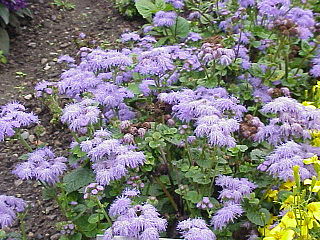
Eupatorieae is a tribe of over 2000 species of plants in the family Asteraceae. Most of the species are native to tropical, subtropical, and warm temperate areas of the Americas, but some are found elsewhere. Well-known members are Stevia rebaudiana, a number of medicinal plants (Eupatorium), and a variety of late summer to autumn blooming garden flowers, including Ageratum (flossflower), Conoclinium (mistflower), and Liatris.

Madia is a genus of annual or perennial usually aromatic herbs with yellow flowers, in the tribe Madieae within the family Asteraceae.

Tageteae is a tribe of the plant family Asteraceae. It consists of approximately 260 species divided among 32 genera. All are found in the New World, with a center of diversity in the Mexican highlands. The type genus is Tagetes (marigolds).

Astereae is a tribe of plants in the family Asteraceae that includes annuals, biennials, perennials, subshrubs, shrubs, and trees. They are found primarily in temperate regions of the world. Plants within the tribe are present nearly worldwide divided into over 250 genera and more than 3,100 species, making it the second-largest tribe in the family behind Senecioneae.

Anthemideae is a tribe of flowering plants in the family, Asteraceae, and the subfamily Asteroideae. They are distributed worldwide with concentrations in central Asia, the Mediterranean Basin, and southern Africa. Most species of plant known as chamomile belong to genera of this tribe.
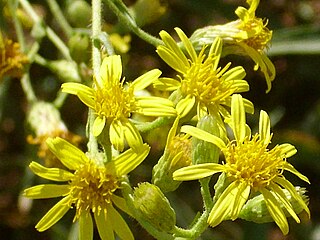
Inuleae is a tribe of flowering plants in the subfamily Asteroideae.
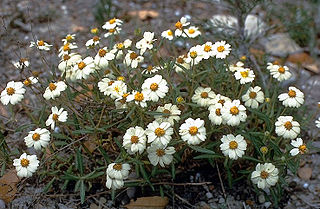
Millerieae is a tribe of flowering plants belonging to the Asteroideae subfamily. Of all the genera, only Galinsoga, Guizotia, and Sigesbeckia have species native to the Old World.
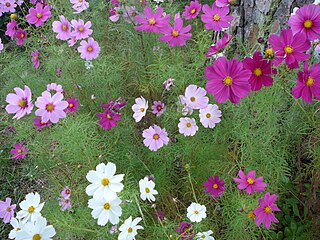
Coreopsideae is a tribe of flowering plants belonging to the Asteroideae subfamily. It includes widely cultivated genera such as Cosmos and Dahlia.
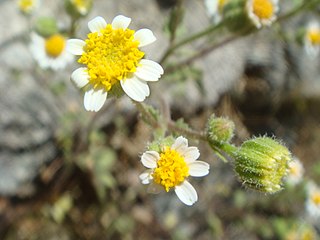
Perityleae is a tribe of flowering plants in the subfamily Asteroideae. The species of its genera are native exclusively to the New World.
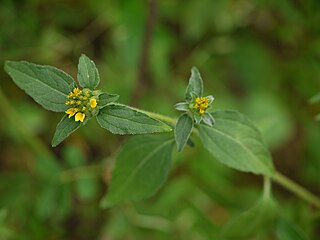
Sclerocarpus is a genus of flowering plants in the tribe Heliantheae within the family Asteraceae. Bonebract is a common name for plants in this genus.

Lipochaeta, common name nehe, is a genus of flowering plants in the family Asteraceae that is endemic to Hawaii.

Helenieae is a tribe of the plant family Asteraceae. The type genus is Helenium, but the best known members of the tribe are the Gaillardia. Helenieae are usually placed in their own tribe, but some authors include this and several other tribes as subtribes within a broader definition of the tribe Heliantheae.
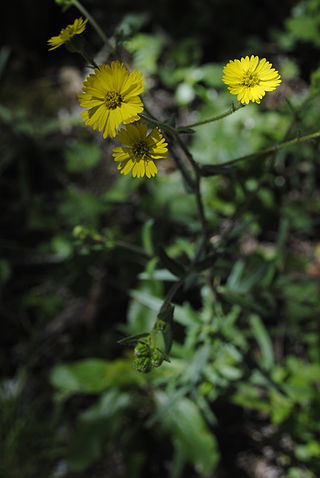
Anisocarpus is a genus of flowering plants in the tribe Madieae within the family Asteraceae.

Mutisieae is a tribe of the family Asteraceae, subfamily Mutisioideae.
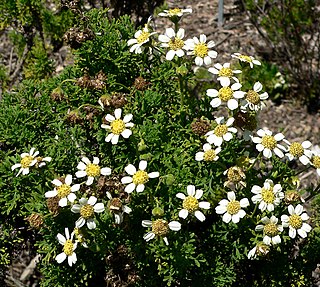
Bahieae is a tribe of plants in the family Asteraceae, mostly native to North America and Mexico. It was described by Baldwin et al. in 2002.

Chaenactideae is a tribe of flowering plants in the subfamily Asteroideae of the family Asteraceae.

Ambrosiinae is a subtribe of flowering plants in the tribe Heliantheae, and is endemic to the Americas.




















